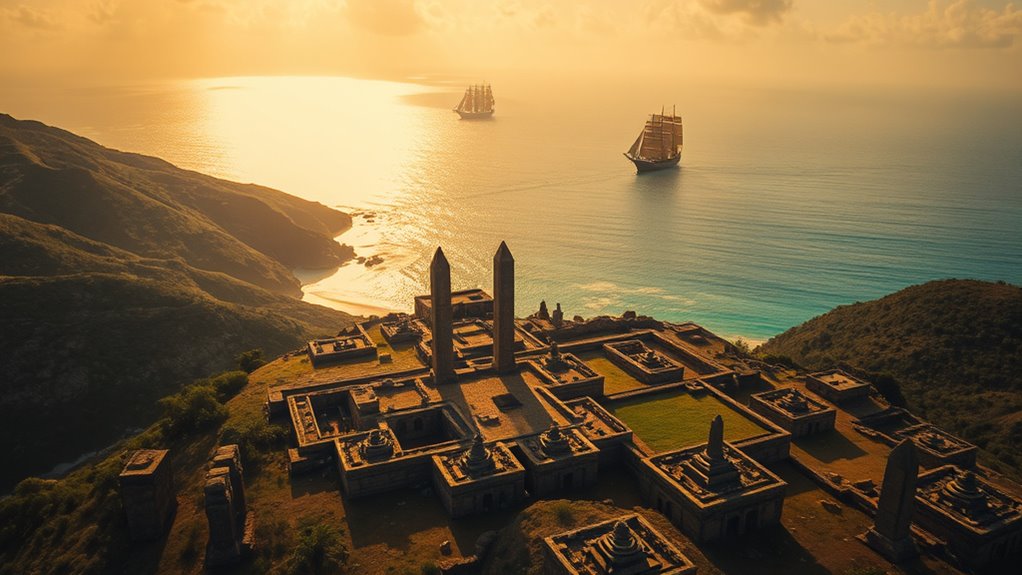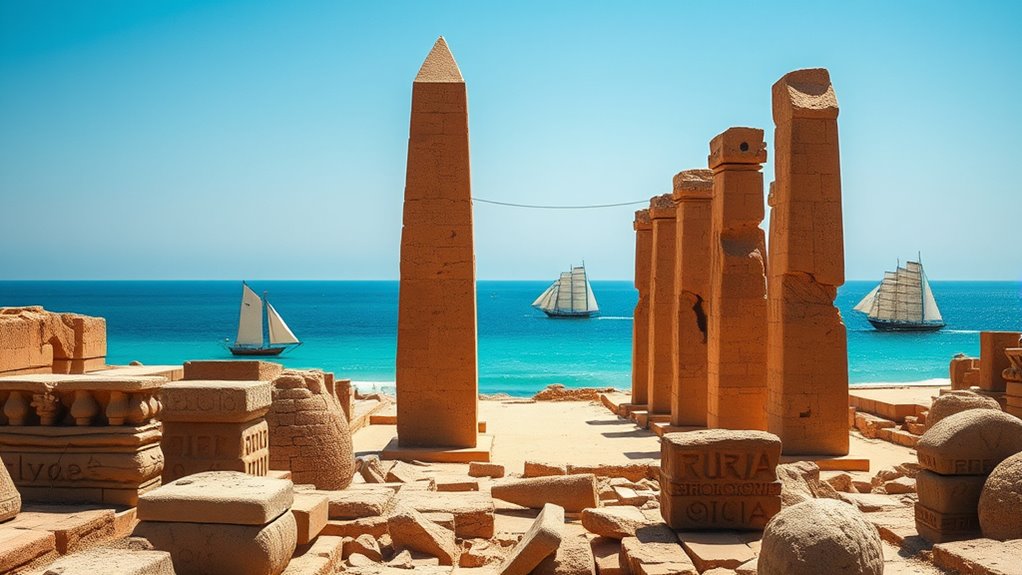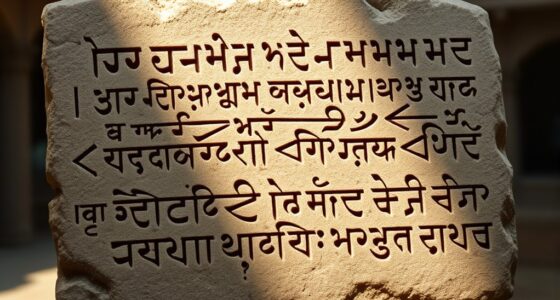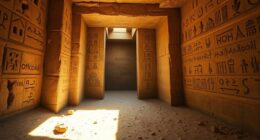The forgotten Kingdom of Aksum was a powerful trading empire in Ethiopia that controlled essential oceanic trade routes connecting Africa, Arabia, and Asia long before Europeans explored the seas. You can see its influence in its coinage, which circulated across distant markets, and its religious and cultural traditions blending indigenous beliefs with Christianity. These trade networks helped establish Aksum as a major hub of commerce, power, and cultural exchange—discover more about how this thriving empire shaped the ancient world.
Key Takeaways
- Aksum was a powerful ancient kingdom in Ethiopia that controlled key trade routes across the Red Sea and Indian Ocean.
- Its coinage, made of gold, silver, and bronze, facilitated long-distance trade and symbolized political authority.
- Aksum’s trade connected Africa, Arabia, and Asia, spreading goods like frankincense, myrrh, and gold across continents.
- The kingdom integrated religion and commerce, with Christianity influencing trade practices and cultural identity.
- Aksum’s maritime trade network played a crucial role in its economic strength and cultural legacy, linking it to distant markets.

Have you ever heard of the ancient kingdom that once thrived in what is now Ethiopia? The Kingdom of Aksum was a powerful civilization that dominated trade routes across the Red Sea and Indian Ocean, connecting Africa, Arabia, and Asia long before European explorers set sail. Its influence extended beyond commerce; it was a cultural and religious hub that left a lasting legacy. You might be surprised to learn how sophisticated Aksum’s economy was, especially through its unique coinage and religious practices.
Aksumite coinage played a pivotal role in establishing the kingdom’s economic strength and political authority. Unlike earlier barter systems, these coins facilitated trade across vast distances, allowing Aksum to assert its dominance in the region. Crafted from gold, silver, and bronze, Aksumite coins often bore inscriptions in Ge’ez and symbols that signified royal authority. They served not just as currency but also as propaganda tools, showcasing the ruler’s legitimacy and divine right to govern. These coins traveled far beyond Aksum’s borders, reaching traders in Arabia, India, and the Mediterranean, therefore cementing Aksum’s reputation as a major trading power. The widespread circulation of coins reflected the economic sophistication of Aksum’s trade networks and its ability to manage complex commerce.
Aksumite coins boosted trade, showcased royal power, and traveled across continents, cementing Aksum’s status as a major trading empire.
Religion was equally indispensable to Aksum’s identity. The Aksumite religion blended indigenous beliefs with influences from Christianity and other regional faiths. It was during the early 4th century that Christianity became the state religion, making Aksum one of the first major civilizations to embrace it officially. This religious shift deeply influenced their art, architecture, and social structure. Monolithic obelisks and churches carved from single stones reflect their spiritual devotion and technological skill. Religious symbols and inscriptions often appeared on their coins and artifacts, underscoring the importance of faith in their political and cultural life.
Your understanding of Aksum isn’t complete without recognizing how its religion and coinage supported its status as a maritime power. The kingdom’s religious institutions often controlled trade routes and resources, reinforcing their influence over both spiritual and economic realms. The adoption of Christianity also helped forge alliances with other Christian kingdoms, expanding Aksum’s reach across the Red Sea and into the Indian Ocean. Its traders carried not only goods like frankincense, myrrh, and gold but also religious ideas that spread across continents.
In essence, Aksum’s legacy lies in its remarkable ability to blend commerce, religion, and politics. Its coinage was more than currency; it was a symbol of sovereignty. Its religion shaped its cultural identity and diplomatic relations. Consequently, these elements allowed Aksum to thrive as a forgotten but influential power that once linked distant lands through oceanic trade routes.
Frequently Asked Questions
What Were the Primary Commodities Traded Along Aksum’S Ocean Routes?
You might wonder what trade route commodities traveled along Aksum’s maritime trade networks. These routes primarily carried luxury items like gold, frankincense, and myrrh, essential for religious and cultural practices. Additionally, you’d find textiles, ivory, and spices, which were highly valued. These goods connected Aksum with distant regions, making maritime trade networks vital for economic growth and cultural exchange, shaping ancient trade dynamics and regional influence.
How Did Aksum’s Maritime Trade Influence Its Cultural Development?
Ironically, you might think maritime trade only boosted wealth, but it also shaped Aksum’s culture through maritime technological innovations and vibrant cultural exchange programs. These exchanges introduced new ideas, religions, and art forms, transforming Aksum’s society. As you navigate these waters, you see how Aksum’s maritime connections didn’t just expand trade—they fostered a rich, diverse cultural identity that still influences the region today.
What Navigational Tools Did Aksum Sailors Use During Their Expeditions?
You wonder what navigational tools Aksum sailors used on their expeditions. They relied on celestial navigation, observing stars and the sun to determine their position, especially during long ocean voyages. Nautical instruments like the astrolabe and compass helped improve accuracy. These tools enabled Aksum sailors to chart their course across vast waters, facilitating their trade routes and expanding their influence into distant lands.
Were There Any Significant Conflicts Over Aksum’S Trade Routes?
You should know that trade disputes and piracy threats shaped Aksum’s maritime history. Historically, there were occasional conflicts over trade routes, especially with rival powers vying for control of lucrative markets. Around 600 CE, pirates posed significant risks, disrupting commerce and forcing sailors to develop better defenses. These challenges highlight how essential and contested Aksum’s oceanic trade routes were, emphasizing their importance in regional power dynamics and economic prosperity.
How Did Climate and Geography Impact Aksum’S Maritime Activities?
You see that climate variability and geography played vital roles in Aksum’s maritime activities. The region’s unpredictable weather patterns, including droughts and storms, affected navigation and trade schedules. Coastal erosion threatened ports and shipping infrastructure, making maritime trade more challenging. These environmental factors forced Aksum to adapt their routes and strategies, shaping their maritime economy and influencing their connections across the Red Sea and Indian Ocean.
Conclusion
So, next time you boast about your global connections, remember Aksum’s forgotten empire. While you scroll through endless news feeds, Aksum’s traders skillfully navigated oceanic routes, shaping history without hashtags or Wi-Fi. Maybe it’s time to put down your device and appreciate a civilization that truly mastered the art of connection—across seas and centuries—without the need for selfies or social media fame. Now that’s a trade route worth remembering.









